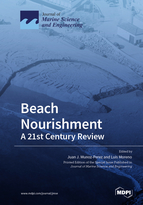Beach Nourishment: A 21st Century Review
A special issue of Journal of Marine Science and Engineering (ISSN 2077-1312).
Deadline for manuscript submissions: closed (31 January 2021) | Viewed by 33676
Special Issue Editors
Interests: reef-supported beaches; sediment transportation; coastal engineering; coastal management; littoral dunes; sand characteristics; sinking phenomenon
Special Issues, Collections and Topics in MDPI journals
Interests: perched beaches; borrow site investigation; beach nourishment; integrated coastal zone management; beach monitoring; ocean instrumentation and forecasting; operational oceanography; submarine groundwater discharges
Special Issue Information
Dear Colleagues,
Erosion is experienced by most of the coastlines worldwide, and it is usually attributed not only to sea level rise but also to the retention of sand in dams, the occupation of dry beaches by urbanized areas, the mining of sand as a building material for construction, and so on. Beach nourishment has evolved as the favoured erosion-mitigation strategy in many areas of the world. The increasing number of people living on the coast, the safety of those people, and the high values of coastal property are all factors that have made beach nourishment a cost-effective strategy for managing erosion in many locations; however, a new scenario of sand scarcity and environmental care has arisen in recent decades. There have been a lot of different and interesting cases of various aspects of beach nourishment in the last years. The purpose of this invited Special Issue is to publish the most exciting experience and research with respect to this topic. Thus, novel techniques for designing, executing, and controlling these kinds of works are welcome. Different case studies and their monitoring results and conclusions are also encouraged, in order to present an updated state of the art for marine scientists, researchers, and engineers. As usual in JMSE, a rapid turn-around time regarding reviewing and publishing will be provided. Moreover, dissemination of the articles will be free for research, teaching, and reference purposes.
High-quality papers are encouraged for publication that are directly related to the following topics:
Beach nourishment design techniques;
Borrow site investigation and environmental-friendly dredging techniques;
Quarry-sand beaches and gravel beach design;
Working with nature;
Representative and unique case studies;
Monitoring results and beach evolution;
The control of qualitative characteristics of the sand;
The cost of renourishment and beach management;
Groins and other structures for sand contention/retention, including innovative methods/technologies;
Beach monitoring—advanced methods;
Beach erosion evaluation.
Dr. Juan J. Munoz-Perez
Dr. Luis Moreno
Guest Editors
Manuscript Submission Information
Manuscripts should be submitted online at www.mdpi.com by registering and logging in to this website. Once you are registered, click here to go to the submission form. Manuscripts can be submitted until the deadline. All submissions that pass pre-check are peer-reviewed. Accepted papers will be published continuously in the journal (as soon as accepted) and will be listed together on the special issue website. Research articles, review articles as well as short communications are invited. For planned papers, a title and short abstract (about 100 words) can be sent to the Editorial Office for announcement on this website.
Submitted manuscripts should not have been published previously, nor be under consideration for publication elsewhere (except conference proceedings papers). All manuscripts are thoroughly refereed through a single-blind peer-review process. A guide for authors and other relevant information for submission of manuscripts is available on the Instructions for Authors page. Journal of Marine Science and Engineering is an international peer-reviewed open access monthly journal published by MDPI.
Please visit the Instructions for Authors page before submitting a manuscript. The Article Processing Charge (APC) for publication in this open access journal is 2600 CHF (Swiss Francs). Submitted papers should be well formatted and use good English. Authors may use MDPI's English editing service prior to publication or during author revisions.
Keywords
- Coastal engineering
- Coastal management
- Sand nourishment design
- Sand dredging.







